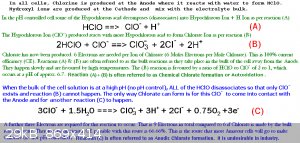
yobbo II - 14-5-2021 at 15:08
Can anyone comment on the delta E (energy) associated with reaction C in the attached picture. Reaction C is how chlorate is made if no acid is added
to a chlorate cell.
It appears that cells run this way have a higher temperature compared to a pH controlled cell.
Is route C more exothermic than A + B, leading to a higher cell temperature, assuming the same current is going into a similar cell?
Yob

[Edited on 14-5-2021 by yobbo II]
phlogiston - 15-5-2021 at 14:00
From your question it looks like what you actually want to know is deltaH, but I'm not really in the mood to explain the difference or calculate it
because its irrelevant to cell temperature, and can be left as an exercise 'left to the reader'
The main reason chlorate cells (or any electrolytic cell) heat up is due to ohmic heating. Simply put: When you apply a voltage to the cell, part of
it is used only to overcome a threshold voltage necessary to allow the reactions to happen that take place at either electrode. The 'rest' of the
voltage is available to overcome the ohmic resistance of the cell electrolyte. Heat will be generated in the cell just like in any resistor, according
to P=I^2*R=V^2/R.
When you increase the voltage, a larger current will flow, resulting in an increased reaction rate and more heat.
The above is simplified, but it will work well as a model to understand how variables like electrolyte concentration, electrode spacing, voltage, etc.
etc. affect your cells operation.
For chlorate cells, reaction B is more efficient, but it only takes place at slightly acidic pH, and it is very slow at room temperature. Therefore,
the cells are generally operated at elevated temperatures, applying insulation or cooling as necessary to reach a temperature of (typically) around
70C.
[Edited on 15-5-2021 by phlogiston]
yobbo II - 15-5-2021 at 16:23
Thanks for reply.
Yes, it is Delta H I was looking for as explained here (from the net)
Updated March 13, 2018
By Ari Reid
In a chemical reaction, delta H represents the sum of the heats of formation, commonly measured in kilojoules per mol (kJ/mol), of the products minus
the sum of those of the reactants. The letter H in this form is equal to a thermodynamic quantity called enthalpy, representing the total heat content
of a system. Enthalpy, measured in joules (J), is equal to the system's internal energy plus the product of the pressure and the volume. The Greek
letter delta looks like a triangle and is used in chemical equations to represent change. Calculating delta H involves balancing the reaction, adding
the heats of formation and finding the difference between the heats of formation of the products and those of the reactants. This method assumes
constant pressure within the system.
Balance the chemical reaction by making sure that you have the same number of atoms of each molecule on the reactant and product sides of the
equation. In a simple example in which water and carbon react to form carbon monoxide and hydrogen gas, the balanced equation looks like this: H2O + C
-> CO + H2. Notice that there are the same number of hydrogen, oxygen and carbon atoms on the left (reactant) and right (product) sides of the
equation.
Look up the heats of formation for the compounds in your equation. There are heats of formation reference tables in most chemistry books, and this
information can also be found through a simple online search. The heat of formation for liquid H2O is –285.83 kJ/mol and for CO is –110.53 kJ/mol,
and the heats of formation for the elements H2 and C are both 0 kJ/mol. If you have a reaction with more than one molecule of a given compound,
multiply the heat of formation value by the number of molecules of that particular compound in your reaction.
---------------------
I have run two similar cells at the same current. One pH controlled and one not. The one that is NOT pH controlled seems to run at a higher
temperaure. (about 20C higher). I am assuming that extra heat is coming from reaction C ?
Yob
It's that I
markx - 16-5-2021 at 22:59
There might be different factors at play besides the enthalphy related effect. E.g. the pH control might affect conductivity and even overvoltages at
the electrodes, thus redistributing the voltage drops across the components of the circuit. This might also contribute to a different temperature
developing in the cells that seemingly run at identical conditions as far as current and overall voltage are concerned.
mysteriusbhoice - 17-5-2021 at 08:31
actually my cells run hot due to the insane amount of current I run the anodes at 32 amps for a 2*6 inch mesh anode in a pH controlled cell using
CaCl2 buffer method.
my CE is 78% and I run at 65 to 70 Celsius.
yobbo II - 17-5-2021 at 15:28
Thanks for replys.
I am not too sure what delta I am looking for!
I suppose the question I am asking is:
Is reaction C more exothermic (or endothermic) than reaction A + B?
As markx points out the whole thing may be much more complicated.
Its a bit like what Woelen was discussing here:
https://woelen.homescience.net/science/chem/exps/miniature_c...
Cathodic reduction of Chlorate is quite exothermic ---> heats cell more that otherwise.
It's a different subject of course (cathodic reduction as opposed to reactions c or a + b) but thats what I was hopeing to find out.
I could perhaps sit down and try to figure it out myself but I am not to well informed in delta this and that, ethtalyps, entropoys etc etc.
